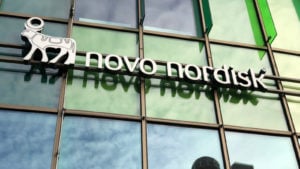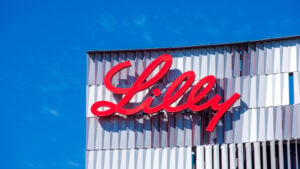Artificial intelligence grabbed most of the headlines last year, but weight loss stocks were equally noteworthy. It grew slowly for several years but really went stratospheric last year.
The wider availability of Ozempic and Wegovy set the world on fire. A class of drugs known as glycogen-like peptide-1 (GLP-1) therapies for diabetes and obesity, demand was fueled by celebrities and social media influencers touting their slimming effects. They also spurred further investment into weight-loss-in-a-pill because why eat healthy and exercise?
Several pharmaceuticals are now pursuing alternatives to the twin blockbuster remedies, so let’s look at which of the leading weight loss stocks might be the best investment.
Novo Nordisk (NVO)

Novo Nordisk (NYSE:NVO) is the frontrunner, owning both Ozempic and Wegovy. The former was approved by the Food & Drug Administration in 2017 to treat type 2 diabetes, and it was discovered that weight loss was a happy side effect. However, it’s not approved for weight loss, but doctors have prescribed it off-label for the morbidly obese. Wegovy, on the other hand, got FDA approval in 2021 as an anti-obesity therapy.
Both drugs contain the active ingredient semaglutide, which increases insulin in the body and helps control blood sugar. Wegovy, though, has higher levels of semaglutide than Ozempic. Novo Nordisk had to stop promoting Wegovy in 2022 because of shortages due to demand. It commercially relaunched the treatment early last year, and sales rocketed even higher.
The drugmaker reported total sales last year increased 36% to $33.7 billion on a currency-adjusted basis as Ozempic sales jumped 66% and Wegovy sales surged 420%. Novo Nordisk has struggled to keep up with demand and has committed to spending $9 billion on new capacity. The risk here is there are potentially severe side effects from the drugs, including gallbladder disease and mental health issues. That poses a risk for the pharma stock as almost 93% of revenue is tied to diabetes and obesity, with 55% of the total coming from Ozempic and Wegovy. Any adverse indications could blow a hole in Novo Nordisk’s business.
Eli Lilly (LLY)

Spurred on by the success of its Danish rival, Eli Lilly (NYSE:LLY) received FDA approval for its own weight-loss treatment, Zepbound. According to the pharma, the drug is the “first and only obesity treatment” that activates both GLP-1 receptors and glucose-dependent insulinotropic polypeptide (GIP) receptors. Approved in November, Zepobound hit the market in December, so we don’t have any sales figures. However, a single treatment costs $1,060, which is about 22% less than the cost for Wegovy. The difference could pressure sales and profit margins for Novo Nordisk, though the drugmaker says 80% of those taking its treatment who are insured only pay $25 per treatment.
Also, like its rival, Lilly sells Mounjaro for diabetes. Both it and Zepbound have the same active ingredient, tirzapetide. Reportedly, Mounjaro is more effective at controlling blood sugar levels than Ozempic but is also more expensive and may have more side effects. Sales of Mounjaro hit $2.9 billion in the first nine months of 2023. Q3 revenue was $1.4 billion, a large sequential increase from the $980 million realized in Q2. Eli Lilly also saw total revenue rise sharply as the year progressed due to the drug’s growth but may see narrower profits from it as discounting occurs.
Eli Lilly looks better situated to capitalize on the growth of Mounjaro and Zepbound. It sells a much more diverse range of drugs, from diabetes and oncology to immunology and neurosciences. Its top diabetes treatment, Trulicity, has sold $5.5 billion this year. Its cancer therapy Verzenio has $2.7 billion in sales. In all, Lilly has seven billion-dollar drugs.
Astra Zeneca (AZN)

Astra Zeneca (NYSE:AZN) is trying to buy its way into the GLP-1 race. In November, it entered an exclusive licensing agreement with Chinese drug company Eccogene for its investigational therapy ECC5004. The pharmaceutical company paid $185 million upfront and could pay out an additional $1.85 billion if the drug hits certain milestones.
ECC5004, though, is only in Phase 1 trials. That puts it far away from actually getting it to market. That’s more akin to Amgen (NASDAQ:AMGN), which has a drug in development AMG133, which recently completed Phase 1 and moved into Phase 2 trials. Pfizer (NYSE:PFE) has its own GLP-1 drug under development, danuglipron, but will not move forward with Phase 3 trials due to severe side effects.
So, it’s a long, costly process for drugs to make it to market with no guarantees. Even after approval, side effects could impact sales and profits. Astra Zeneca has several other therapies under development for oncology and other diseases that hold promise for success. It also offers a better valuation than either Novo Nordisk or Eli Lilly. However, it might not be in the same class as its peers regarding weight loss.
That suggests it is Novo Nordisk’s game to lose, though sales and margins are pressured from Lilly’s Zepbound. Yet, with both weight-loss stocks engaging in discounting, the field may be higher than expected. That ought to give Novo Nordisk the edge with its substantial market dominance.
On the date of publication, Rich Duprey did not hold (either directly or indirectly) any positions in the securities mentioned in this article. The opinions expressed in this article are those of the writer, subject to the InvestorPlace.com Publishing Guidelines.
